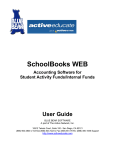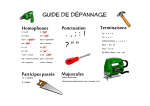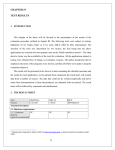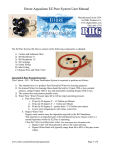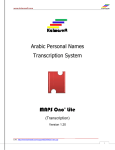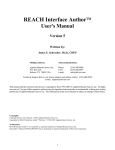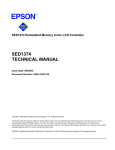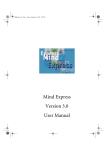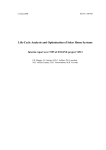Download WordSprint
Transcript
WordSprint User Manual Your computer can read out this manual! You can find this manual under Documents in the WordSprint folder (this is default C:\Program Files\WordSprint english\Word Documents). Do not forget to turn on the volume of your computer! Copyright © Copyright Technologie & Integratie All rights reserved. No part of this publication may be reproduced, transferred, copied or stored in a retrieval system or translated into any language or computer language in any form or by any means, be it electronic, mechanical, magnetic, optical, chemical, manual or otherwise, without the prior written permission of Technologie & Integratie. The WordSprint software is property of Technologie & Integratie and is protected by copyright laws and the international copyright conventions. WordSprint has been developed in association with vzw Die-’s-Lekti-kus and is based on the expertise of vzw *Eureka* Education. Technologie & Integratie St-Pietersnieuwstraat 41 9000 Gent, België [email protected] www.tni.be -2- Table of contents Chapter 1 – Introduction…………………………………………………………………………………………………5 1.1 Target group………………………………………………………………………………………………………………..5 1.2 WordSprint objectives……………………………………………………………………………………………..5 1.3 System requirements…………………………………………………………………………………………………5 1.4 Licences…………………………………………………………………………………………………………………………6 Chapter 2 – Installation and first use………………………………………………………………………….7 2.1 Installation………………………………………………………………………………………………………………..…7 2.2 Listening to the manual………………………………………………………………………………………..…..7 Chapter 3 – Short manual………………………………………………………………………………………..………8 Word toolbar………………………………………………………………………………………………………………..…….8 Chapter 4 – Working with WordSprint for beginners………………………………………..….…11 4.1 How can WordSprint read texts in Word?..............................................................11 4.2 How can I listen to difficult words in a text?........................................................11 4.3 How can I follow WordSprint’s reading?.................................................................11 4.4 How can WordSprint read as I type?......................................................................12 4.5 How can WordSprint pause between words? ……………………………………………..………13 4.6 How can WordSprint read email, internet?............................................................13 4.7 How can WordSprint read faster or slower?.........................................................15 4.8 How can I scan a text and read that text?............................................................16 4.9 How do I work with the WordSprint word processor?........................................16 Chapter 5 - WordSprint for advanced users……………………………………..………………………17 5.1 Adjusting the pronunciation of words………………………………………………………..………….17 5.2. How can I mark and summarize text?.....................................................................18 5.3 Adding homophones……………………………………………………………………………………………..…….19 5.4 Saving text as sound file…………………………………………………………………………………….……20 Chapter 6 – WordSprintPDF………………………………………………………………………………………….22 6.1 How to read PDF documents in WordSprintPDF?.................................................22 6.2 How to fill in a PDF document?..................................................................................25 6.3 How to edit a PDF document?....................................................................................25 Chapter 7 - WordSprint and dyslexic children (tips for parents and professionals)….34 7.1. Remediation……………………………………………………………………………………………………………….34 7.2. Compensating……………………………………………………………………………………………………….….…35 -3- Chapter 8 - Tips for students and adults…………………………………………………………………. 37 8.1 Studying……………………………………………………………………………………………………………………..37 8.2 Reading……………………………………………………………………………………………………………………….37 8.3 Writing……………………………………………………………………………………………………………………….38 Skippy………………………………………………………………………………………………………………………………….39 Chapter 1 – What is Skippy?..............................................................................................40 Chapter 2 – Selecting a prediction……………………………………………………………………………….42 Chapter 3 – Derivations and compositions…………………………………………………………………..43 Chapter 4 – Wordlists……………………………………………………………………..………………………………45 4.1 Selecting a wordlist……………………………………………………………………………………………………45 4.2 Creating a wordlist…………………………………………………………………………………………………….45 4.3 Modifying a wordlist………………………………………………………………………………………………….46 4.4 Adding abbreviations to a wordlist………………………………………………………………………..49 4.5 Cropping a wordlist……………………………………………………………………………………………………50 Chapter 5 – Settings……………………………………………………………………………………………….………52 5.1 Prediction…………………………………………………………………………………………………………….………52 5.2 Layout…………………………………………………………………………………………………………….…………….53 5.3 Window…………………………………………………………………………………………………………….…..……..56 5.4 Dwelling……………………………………………………………………………………………………….……………….58 5.5 Startwords……………………………………………………………………………………………………….…………59 5.6 Extra………………………………………………………………………………………………………………….…………61 Chapter 6 – System menu options…………………………………………………………………………………63 Appendix…………………………………………………………………………………………………………………………….64 I. UK English…………………………………………………………………………………………………………………… 64 Vowels and diphthongs…………………………………………………………………………………………………….64 Consonants…………………………………………………………………………………………………………………………65 II. US English……………………………………………………………………………………………………………………66 Vowels and diphthongs…………………………………………………………………………………………………….66 Consonants………………………………………………………………………………………………………………………….67 -4- Chapter 1 - Introduction 1.1 Target group WordSprint helps children, youngsters and adults with reading, writing and spelling problems, like for instance dyslexia. WordSprint can be used for remediation and practice with young children. But also to prepare texts and lessons. It can even be used to learn foreign languages. For pupils in secondary school or students in the higher education it can be a very useful appliance. Also adults can get much profit out of it. 1.2 Sprint objectives WordSprint reads out texts and documents. Listen to the complete text or have Sprint read out the text per sentence or per word. You also hear what you type. That way, you notice typing errors much faster. WordSprint can read words syllabically or can spell the words phonetically. Sprint can search for all homophones in a text, like ‘meet’ and ‘meat’. By means of a drawing, a short explanation or a sample sentence you quickly select the correct word. WordSprint has its own word processor, but you can also use it in Microsoft Word. You use the Word toolbar to help you with reading, writing and spelling. Sprint reads internet texts or mails as well. 1.3 System requirements In order to use WordSprint efficiently, the system has to meet some minimum requirements. The minimum system requirements are the following: • Pentium II PC (300 MHz) or faster • 64 MB RAM • MS Windows 98 or Windows NT, or later • Sound card (preferably 16 bit), compatible with Multimedia system (MMSYSTEM). For the Word toolbar you need Word 2000 or higher. The toolbar can be used in Word 97, but with some restrictions. -5- 1.4 Licences WordSprint is protected by software protection. When you start up the program, you see the next window: Click Register and follow the steps of the registration process. For this, you need the WordSprint serial number. This serial number is on the registration card. This card tells you • how to register Sprint • how to transfer WordSprint from one computer to another • how to remove the license and install it again later Click Start Sprint if you wish to register later. For 30 days you can start up WordSprint without registering. After that, registration is necessary in order to start Sprint. -6- Chapter 2 - Installation and first use 2.1 Installation Put the WordSprint CD-Rom in the CD-Rom drive. When installation does not start immediately, go to Start > Run and start the setup of the CD-Rom. Follow the instructions on the screen in order to install the program correctly. During installation, choose whether you wish to install the Word toolbar or not. 2.2 Listening to the manual Sprint can read out this manual: Start up WordSprint, open the file ‘SprintMan.rtf’ and click this button to have WordSprint read the whole document: Sprint can also read the manual in Microsoft Word. -7- Chapter 3 – Short Manual Word toolbar Read the complete text. Read rest of text (from the position of the cursor onwards). Don’t change anything in the document while WordSprint is reading. Read previous, current or next. Select the units you want to hear: • words • sentences • paragraphs • read phonetically (sound by sound) • syllables • synthesis: sound by sound and then the word • spell: sound by sound like in the alphabet Voice • • • • speed read slowly default speed read fast read very fast With you can refine the speed. Stop speech. -8- Click and read. Use this to read only difficult words or parts of the text. • • • First click this button. Then click on a word in the text. Sprint reads the preset unit: paragraph, sentence, word … • Disable Click and read by clicking the button again. (a) Voice and language z Adjust the volume. z Define the voice speed. (b) Homophones • Click this button to mark the homophones. Homophones are words that sound the same, but that are spelled differently, like ‘meat’ and meet . • meat and meet • WordSprint underlines words like ‘meet’ and ‘meat’ and puts them in blue in the Sprint word processor. In Word WordSprint puts them in a box. Double click in a box. Sprint displays a drawing, some explanation and sample sentences. -9- • • • Click the speaker next to a homophone. WordSprint reads the explanation and sample sentences. Click the drawing of the right word. This word is then inserted into the text. Click the button again to switch off homophones. - 10 - Chapter 4 – Sprint for beginners 4.1 How can WordSprint read texts in Word? • • • Open an existing document in Word. Or create a new document! Use the toolbar which you see above. You can find explanation on all buttons in the previous text. 4.2 How can I listen to difficult words in a text? • • Select Words in the list next to the blue arrow. Click the Click and read button. • Click on a difficult word in the text. Sprint reads the word immediately. 4.3 How can I track WordSprint’s reading? While reading, Sprint colours the words you hear. With a second colour, WordSprint can mark the sentence or paragraph that is being read. To switch on or off this option: Click the following button: You can see this window: - 11 - Check the Foreground colour option. Sprint then colours the words while reading. Check the Background colour option. WordSprint then colours the full sentence or paragraph while reading. To change the colours: Click Change and choose a colour. 4.4 How can Sprint read as I type? Click this button: You can see this window: • • • Check Speak while typing Check Speak while typing in other applications (You have to enable this for Word). Choose when WordSprint should read. (after each character, after every sentence…) - 12 - 4.5 How can WordSprint pause between words or sentences? If you want pauses between words, Sprint can read a text or wordlist word by word. WordSprint can also read the whole text and automatically add word pauses. A. word by word • • Select Words in the list next to the blue arrow in the Sprint toolbar. Use the blue buttons. Read the previous, current or next word. B. whole text • Click the Voice settings button. • • • • Under Extra pauses while reading, check Extra pause after words or Extra pause after sentences. Choose the length of the pause. Close the Voice settings. Open a wordlist and click the Read complete text button. • Under Extra pauses, choose No extra pauses to read normally again. 4.6 How can WordSprint read email, internet? Use Sprinter to read internet or email. To start up Sprinter: z z Right click the Sprint icon at the bottom of the screen (next to the clock). Choose Sprinter in the menu. - 13 - You can see the following button on the screen: You can also start up Sprinter as follows. Start up the WordSprint word processor. Choose View in the menu bar and then choose Sprinter. The Sprinter button appears on the screen. Listening to text • • • • Select the text you want Sprint to read. Then click the Sprinter button. The button changes into a square and Sprint reads the text. Click the square to stop speech. To select text: • • • • Move the mouse pointer to the beginning of the part of the text. Hold the left mouse button. Move the mouse pointer to the end of the text. Let go of the mouse button. • To select a word, double click the word. • To select a paragraph, quickly click three times in that paragraph. • Choose Select all or press Ctrl+A to select the whole text. How to move Sprinter? • • Click the sprinter button and hold the left mouse button. Now move the mouse to the desired position. - 14 - Sprinter settings Right click Sprinter. A menu appears. With this menu you can: • • • choose the language of the reading voice. change Sprinter’s size. close Sprinter. 4.7 How can WordSprint read faster or slower? In the toolbar you can adjust the speed. Choose between Read slowly, Default speed, Read fast and Read very fast. You can also set the speed with this button: Internet or email To read emails or internet pages, use the Sprinter button. WordSprinter uses the same voice settings as in Word and Sprint. To read faster or slower, set the desired speed in Word or WordSprint. 4.8 How can I scan text and read that text? To scan text, you need: • a scanner. • software that converts the scanned page into text (like Omnipage Pro). When the document is converted into text, Sprint can read the text. - 15 - 4.9 How do I work with the WordSprint word processor? Sprint contains a simple, speaking word processor. It has the same features as the WordSprint toolbar in Word. Open Sprint by means of this button on the desktop. In the WordSprint word processor, you can: • • use extra big buttons to make it easier to read your documents. mark key words or key sentences with the markers. Sprint then summarizes the text. This makes studying easier. • save the whole text as a sound file (WAV or MP3). That means you don’t always need a computer to listen to a document. You can even study while you are walking or cycling. Note that in this program you cannot open Word texts! (But you can also use the markers tools in a Word document.) - 16 - Chapter 5 – WordSprint for advanced users 5.1 Adjusting the pronunciation of words Some words will not be pronounced correctly. Proper names can easily create problems. By means of the pronunciation dictionary you can adjust the pronunciation of words. You can also replace words. You can, for instance, replace ‘DA’ by ‘Disctrict Attorney’. Click the Settings button. The Settings window appears. z z If you’re working with Word, this Settings window appears: If you’re working with the Sprint word processor, this Settings window appears: Click Change/Edit next to Dictionaries. The following window then appears: - 17 - Click Add word to add a new word to the list. Type the word in the right top corner. Below that, type the new pronunciation. Use the phonetic alphabet for this (see Appendix). Or try a different spelling for the word so that it is pronounced correctly: Example: Stephanie Fonetic: stEfAnI Other spelling: stefani If you want to adjust a word from the list, click the word and adjust the pronunciation. To delete a word from the list, click the word and then the Delete word button. WordSprint can read out abbreviations as full words. Example: e.g. : for example, exc. : except, etc. : et cetera 5.2. How can I mark and summarize text? In Word 1. Click the Marker button of the Reviewing toolbar. 2. Select the text or picture that you want to mark with the mouse pointer. If you want to mark a word, click this word twice. If you want to mark a paragraph, click the paragraph three times. 3. Select the next element that you want mark. 4. If you want to stop marking, click the Marker button once more or press ESC. - 18 - In Word you can generate an automatic summary of a document: Click Auto summary in the Extra menu. Choose the type of summary and the percentage of the original document or the summary level. In Sprint In the WordSprint toolbar you find a number of markers (red, yellow, blue and green). Use these to mark key words or key sentences in a document. Use Wipe markings to undo markings: Click the Summarize button to get a summary of your markings. The summary will put all marked words and sentences in a new document. 5.3 Adding homophones You can complete or adjust the list of homophones. Click the Settings button. Click Change next to the list of homophones. The following window appears: Click on a word in the list. On the right-hand side you see: - 19 - • • • • the word a short explanation one or more sample sentences the picture You can change the explanation and the sample sentences in this window. Click Browse if you want to use an other picture. If you uncheck Highlight in text, this word is no longer marked as a homophone in the text. In the Homophones window, you can connect the words through the Add button. The word ‘four’, for instance, is connected to the word ‘for’. When you doubleclick the homophone ‘four’ in a text, this window pops up: 5.4 Saving text as sound file In Sprint, you can save a text or part of a text as WAV or MP3 file. You can then play this sound file on any computer. Or listen to it with an MP3 player. You can only save a text as sound file in the WordSprint word processor. Open or type the document that you want to save as sounds file. If you wish to save only a part of a text, then first select that part in your document. Select Speech in the menu bar and choose Record Text - 20 - Give the sound file a name. Click OK. The recording of the sound file starts. The beginning and ending of the recording are marked by a distinctive sound. - 21 - Chapter 6 – SprintPDF WordSprintPDF reads out digital PDF documents like handbooks, (school) books, course books and other documents. If one of your schoolbooks is digitally available you don’t need to scan it. SprintPDF gives you the possibility to fill in worksheets in exercise books and to have them print. WordSprint PDF helps out teachers, students, pupils and parents to gain in time. It is especially adapted to children, students and adults suffering from dyslexia. 6.1 How to read PDF documents in SpintPDF? How to open a document? • • • Click to open a file or choose File > Open to open a document. Select the PDF document you want to read. Click Open How to read a document? - 22 - Read complete text Read rest of text Read previous/current/next ( word/sentence/page) depending on what you have selected. Click and read Is useful to read complicated parts of texts or to read difficult words. • Click click and read to activate the ‘click and read ’ action. • Click a word in the text • Sprint PDF will read the word, sentence or page, depending on what you have selected. • To switch out the ‘click and read ’ option click the ‘click and read ’ button again. How to browse a PDF document? Use the browser in the menu bar: Next page Previous page Go to last page Go to first page - 23 - Click the browser, enter the page you want to consult and press enter How to zoom in/out? With the zoom you can define the format of your text document. Fit page Page width Zoom out Zoom in Click this window and fill in the desired page size. How to turn a page? PDF documents can be turned 90% to the left or to the right. This tool is useful when a document is turned over when opening it. With this function allows you to set your document right. • Select Edit > Turn page clockwise (to the right) • Select Edit > Turn page counterclockwise (to the left) - 24 - 6.2 How to fill in a PDF document? The start typing function in WordSprintPDF allows you to fill in the worksheets of your exercise book and to print your answers. Depending on the security of the PDF document: • • • The entire sheet will be printed. The questions will be printed faded and the answers plain. Only the answers will be printed. Use the pen in the toolbar to fill in your worksheets. • • • Click Start typing Click the place you want to fill in Type your answer on your worksheet To hear your answers click 6.3 How to edit a PDF document? With these 4 functions you can edit PDF documents to obtain optimal reading results. Ignore tool: To avoid reading unnecessary information like page number, title, etc. Order tool: With this tool you can define the reading order of the document. It is useful when you are reading a document set up in columns. Correction tool: To read symbols, math formulas, abbreviations, etc. Image tool: To read titles of figures and tables. - 25 - How to avoid reading unnecessary information? With the Ignore tool : SprintPDF does not read unnecessary information like page, numbers etc. • Click the ignore tool • While holding the left mouse button, move the orange field that appears over the part of the text you don’t want to hear, when the part you want to ignore is selected release. How to undo the Ignore tool? • Click the Ignore tool • Click the orange field. Black squares appear on the corners of the field. • Delete To select several fields at once: Ctrl + left mouse click. How to define the reading order? With the order tool you can select parts of text and mark them to define a reading order. If you want WordSprintPDF to read a document with a column setup select the first column and then the second one to avoid Sprint to read them as continuous text. • Click the order tool - 26 - • • • • • While holding the left mouse button move the green field over the first part of the text you want to hear, when your selection is done release. Repeat this step to select other parts of text. The fields are automatically numbered (an order number appears on the left corner top of the selected fields). If you want to change the reading order of the selected text, go to the menu bar and select Edit > Change order. Click the green fields in the order you want them to be read. To have them read click Note once you have selected a part or parts of the text with the order tool, WordSprint PDF will only read the selected items on this page. If you want SprintPDF to read other parts of the page you have to select this text first! To undo the order tool, click and click the green field, then Delete. (To select more than one file: Ctrl + left mouse click. - 27 - How to read symbols, formulas, abbreviations etc. in the text? With the correction tool WordSprintPDf is able to read symbols and maths formulas. • Click the correction tool • While holding the left mouse button move the blue field over the symbol or formula you want to hear, then release. • When releasing the left mouse button a correction window appears. • Type the meaning of the symbol • Click Ok How to read titles and explanation of tables and figures. With the image tool you can read titles and explanation of tables and figures. • Click the figure tool • While holding the left mouse button move the purple field over the title and figure and then release. • Click the table or frame and SprintPDF will read the title or explanation. - 28 - How to join text to a frame or figure? With the image tool you can also join text to a frame or figure. Click the image tool. Select with the purple field the figure. Right mouse click. The correction window appears. Type the text in the correction window. Click Ok. WordSprintPDf will read the introduced text when you click the frame. Extra How to apply a function to the entire document? A function can be applied to an entire document. For example; if you don’t want to hear the page numbers on each page of a document you can apply the ignore tool for page numbers to the whole document. - 29 - • • • • • Click the tool of your choice: ignore tool, order tool, correction tool or image tool. While holding the left mouse button, move the coloured field over the text or figure. Click the coloured field. Black squares appear on the field. Go to the menu bar and select Edit > Apply selection to… You can choose whether you want to apply the selection to o All pages o All odd pages o All even pages o Range (to select pages) - 30 - How can I see what has been edited on a document? If you click any of the tools, every part of the text where the tools (ignore, order, correction, image) are active becomes visible in the document. The edited parts are indicated by coloured shaded areas or by a crossed field. - 31 - Click a field and press delete to undo a tool. If you want to delete several actions, then press Ctrl + left mouse click and select the fields you want to delete. How to save a file as a secure PDF document? In SprintPDF a text is always secured. The copy, paste and cut actions can not be used. Moreover you can give your PDF document a higher security. You can choose to save your document as a Sprint Secure PDF (SSP-extension). In that case this document can only be opened with SprintPDF. In this format there is a print security. • • • • • • • • • Choose Edit > Save as… Choose between PDF or Sprint Secure PDF. Choose Sprint Secure PDF. Choose a name for your document. Select Save. Enter your password. A Security window appears. Choose a password. You will only need this password to adapt the print security there after, you won’t need it to open the document. Confirm your password. Choose: o Don’t print: only de added answers or text can be printed, not the document. o Print background: The PDF document will be printed shaded, to prevent copying it. The answers are printed plain. This way the teacher can read the answers of the student next to the shaded printed questions. o Print allowed: The entire PDF document will be printed. o Select OK. Note: You can only read Sprint Secure Documents with SprintPDF. - 32 - How to change the secured settings of a Sprint Secure Document? Choose Edit > Security… in the menu bar. Insert your password. Adapt the print security. Click OK. The Menu Bar Go to the menu bar and select Edit. Choose one of following functions: Ignore Order Change Order Correct text Image Apply selection to… Turn page clockwise Turn page counterclockwise Type text Security You can also adapt the view of your page in the menu bar. Choose View > Zoom. o Fit page o Page width o Zoom in o Zoom out - 33 - Make the toolbars you want appear on the screen: go to View > Toolbars. The selected toolbars will be visible in the SprintPDF window. You also can choose Not to display some toolbars. . Chapter 7 - WordSprint and dyslexic children (tips for parents and professionals) 7.1 Remediation The parent, speech therapist or teacher can use Sprint for remediation or exercise. A few tips. Improving spelling Tip 1 Dictate a sentence. The child types the sentence. Have WordSprint read after every word or every sentence. The child then immediately hears a number of errors. Tip 2 The child spontaneously types a text. Have Sprint read word per word or sentence per sentence. Tips 3 Teach the child how to use the spelling checker. Teach it how to use WordSprint for a reading control. Tip 4 Teach the child how to use the ‘homophones’ function. Facilitating reading Tip 1: Analysis to synthesis Have Sprint read the words sound by sound (analysis). The child pronounces the word. The computer reads again (synthesis). - 34 - Tip 2: Synthesis to analysis and back to synthesis De computer reads the word. The child spells. The computer reads again. Beginning readers Text Tip 3: Tracking WordSprint’s reading Have Sprint read the text (that contains words with the difficulties you want to practise). Use the Highlights. That way, the child can easily follow the position in the text. The child tries to read the text as WordSprint is reading. Tip 4: Preparing difficult words Mark the words you want to prepare. Have Sprint read the marked words. Discuss the difficulties. Practise partly skills (depending on the problem word). Auditory synthesis, auditory analysis, knowledge of the letters, learning to recognize soundcharacter clusters ... After practising, the pupil reads the marked words in the text. After every word, have WordSprint read the word so that the pupil can check its pronunciation. Tip 5: Integrating difficult words Disable the marked words. The pupil now reads the text as the computer voice reads it. Forcing the pace Tip 6: Following with the eyes First have Sprint read the text at normal speed and after that at higher speed. The child tries to follow in the text with the eyes. Tip 7: Automation of texts Have WordSprint read the text. The child reads as the computer voice reads. Daily force up the speed. Exercise the same text for a whole week. 7.2. Compensating Tips for parents, teachers and instructors. Tip 1: Typing characters and hearing what you type In the beginning, have Sprint read every character that the child types. - 35 - Tip 3: Pre-teaching reading Have WordSprint read texts that will be treated in the classroom in advance. That way, pupils will experience success. Tip 4: Tests and exams When reading is very laborious for a pupil, you can have Sprint read tests and exams. The child can use a head phone so that the other pupils are not disturbed. Tips for youngsters and parents Tip 5: Homework and lessons Reading lessons Concentrate on listening. Structure the text. Mark key words and main ideas. Tip 6: Typing and listening Type the key words or short bits of text. Have WordSprint read them. Typing can help to memorize. - 36 - Chapter 8 - Tips for students and adults 8.1 Studying Tip 1: Listening Have Sprint read texts that you have to study. Listen to the text several times. Use different speeds. Choose the speed that works best for you. Ask your teacher or instructor to provide you with the course in Word. If that is not possible, scan the texts or course books. Tip 2: Marking and summarising Mark titles with the same colour: chapter titles, paragraph titles. Mark conclusions or definitions with another colour. You can also colour the contents according to a system. For instance: new concepts, names, dates = yellow = memory work definitions of concepts, explanation of concepts, names and dates = green = key explanation properties, characteristics, answers to how-question = red examples = blue Have WordSprint summarise the text. You then get a text which contains only the marked bits. Have Sprint read the text again. Study! Check! 8.2 Reading Tip 1: Reading and font Try different fonts and decide on the right one for you. (Arial, Comic, Times new roman ...) Increase the font size if necessary. This way you can read the text and follow. Have WordSprint mark in colour what you are reading. Keep up the speed. This way, you train your reading skills. Tip 2: Reading the newspaper Subscribe to the digital version of a newspaper. Have Sprint read it. - 37 - Tip 3: Mails and internet Have WordSprint read mails and website texts. Have Sprint read at different speed and decide on the right one for you. You can choose the reading speed in the WordSprint program or in Word or hold the right mouse button on the Sprinter icon and choose the speed. WordSprint will use the same speed when reading mails or internet texts. 8.3 Writing Tip 1: Avoiding errors If you want to send a mail, first type your text in Word. Use the spelling checker. Then have Sprint read your text. You will hear the spelling errors. Use the ‘Homophones’ function as a control. Correct, copy and paste the text in your email. Tip 2: Word prediction This is especially useful if you frequently doubt the spelling of words and if you type slowly. Type some characters and WordSprint predicts what your want to type. Click the right word. This way, you need less key strokes. Moreover, you know that the word is spelled correctly. How? Type a character. A list of (for instance) ten words appears. These ten words start with that character. The list contains words you are likely to type. Example: You want to type the word ' immediately ' correctly. After typing the ‘i’, the program will suggest words like ‘in’ and ‘it’. After typing the third character ‘imm’ the list suggests The word ‘immediately’. With one more keystroke (F1 or 1 to select the word, for more explanation see following chapter ‘Skippy’), the complete word is on your screen, spelled correctly. Word prediction proceeds very quickly. This means you only need four keystrokes to see the correct spelling of ‘immediately’ on the screen. Word prediction thus proceeds very quickly. The program will remember the words which you frequently use and will predict those sooner. Of course you have to type the first characters correctly. If you - 38 - start with an ‘n’ to write down the word knowledge, then the prediction tool won’t help. This option is less useful if reading is very laborious for you, since the selection of the correctly spelled word first requires reading of the prediction list. Skippy Word prediction - 39 - Chapter 1 – What is Skippy? Skippy is a powerful word prediction program that helps you with typing. The program can predict the word you want to type. At each character you type, Skippy adjusts the prediction list. Skippy can be used with any word processor. With word prediction you can save a huge amount (up to fifty percent) of the normal keystrokes. Example: When you type ‘con’, Skippy displays the following words. All of these words start with ‘con’: constitution, condition, consider, continued, contrary, considered, considerable. As soon as you type an extra character, Skippy adjusts the wordlist. To write the word ‘conversation’, typing the characters c, o, n and v should suffice to make the complete word appear in the list. - 40 - Click the word in the list to insert it into the text automatically. You can also select the word by means of the keyboard (see chapter 2). When a word is inserted, Skippy adds a space. When a complete word has been typed, Skippy predicts the following word (word pairs). Skippy can learn your own vocabulary. Thus words which you frequently use will be predicted even faster. Skippy contains numerous options to adapt the prediction to the needs and wishes of the user. - 41 - Chapter 2 – Selecting a prediction There are three ways to select a word from the prediction list: Click on the word you want to insert into the text from the prediction list. Use the function keys F1 to F10 to select a word from the prediction list. Use F3 to select the third word from the prediction list. To be able to use the function keys for selection, click Menu > Settings > Extra and check the option Use function keys to select predictions. Use the keys of the numeric keypad to select a word from the prediction list. Use numeric key 7 to select the seventh word from the prediction list. To be able to use the numeric keypad for selection, click Menu > Settings > Extra and check the option Use numeric keypad to select predictions. Use the function keys F11 and F12 to scroll the prediction list. Use F 12 to display the next list of predictions, Use F11 to display the previous list. The - and + of the numeric keypad can be used for the same purpose. For this, make sure that, under Menu > Settings > Extra, the option Use numeric keypad to select predictions is checked. - 42 - Chapter 3 – Derivations and compositions Skippy makes it easy to type derivations and compositions. Suppose you want to type the word ‘greengrocer’. When the letters g and r are typed, the word ‘greengrocer’ is not in the prediction list yet, but the word ‘green’ is. Insert the word ‘green’ into the text and press Backspace to delete the automatically added space. The prediction list now contains only words starting with ‘green’. The word ‘greengrocer’ is one of them. - 43 - Select the word ‘greengrocer’. Skippy now automatically replaces the word ‘green’ by ‘greengrocer’. That way you type the word ‘greengrocer’ (and a space) with only 5 keystrokes: • type ‘g’ • type ‘r’ • select ‘green’ • use Backspace to remove the space • select ‘greengrocer’ In this example, no less than 7 keystrokes are saved. The same procedures can be followed to type compositions such as ‘safety-belt’ or derivations such as ‘foundations’. - 44 - Chapter 4 – Wordlists Skippy bases its predictions on an extensive wordlist. That wordlist contains information on words and word pairs. By modifying a word list, predictions can change. Skippy can learn your own vocabulary. You can have Skippy modify the word list as you are typing. Or Skippy can learn existing text files. You can also edit the word list manually and even create new word lists. For most texts, the standard wordlist will do. If you frequently write texts on football, for instance, you would better use a wordlist that contains a lot of specific football expressions and idioms. The program can also combine, for example, the standard English wordlist with a ‘football wordlist’. In this chapter you will learn how to select, create and modify a word list. 4.1 Selecting a wordlist To select a wordlist, click Menu > Wordlist. Select a wordlist from all existing wordlists in the top window. 4.2 Creating a wordlist To create a new word, click Menu > Wordlist. Click New list in the List dialogue box. Give the new wordlist a name. The new wordlist is still empty. To fill the list, you have Skippy: • Learn words as you type • Learn words by means of existing text files • Add words to the wordlist manually - 45 - 4.3 Modifying a wordlist Modifying as you type Skippy can learn new words and/or word pairs as you are typing. Skippy will then also adjust the frequency of words that are already in the list, depending on how many times a word is typed. This way words which you type frequently will appear in the prediction list a lot sooner. To modify the wordlist as you type, choose Menu > Settings. In the Learning part of the Prediction tab, check the option Add every new typed word. Skippy can • Learn single words only • Learn word pairs only • Learn both single words and word pairs If you do not want the contents of an original wordlist to change, you should not check this option or you should copy the original word list and make changes in that copy only. Modifying by means of text files Click Menu > Wordlist. Select the list you want to modify. Click Learn text. Now select one or more text files you want Skippy to learn. The words and/or word pairs from those text files are added to the wordlist. Make sure that the text files have been saved as normal Windows text files (ASCII format). Click Open and choose one of the following options: • Learn single words only • Learn word pairs only • Learn both single words and word pairs - 46 - Click Start. Skippy now starts building a wordlist based on the selected text files. Click OK if you actually want to include the words and/or word pairs in the wordlist. Copying wordlists allows you to create new wordlists without having to modify the original wordlists. Copy the standard English wordlist and give the copy a name. Skippy can then learn other words from text files (on the subject football, for example) and put those words into the new wordlist. That way, Skippy can rapidly predict football expressions, but also the regular English words and word pairs. Modifying a wordlist manually You can add words to the wordlist so that they will appear in the prediction list. You can delete or correct words (e.g. words that are spelled incorrectly) from a wordlist. You can change the frequency of words so that they will appear sooner or later in the prediction list. Click Menu > Wordlist > Edit. In this dialogue box, there are several editing possibilities: You can search for a word. Type e.g. ‘the’ and click Search. Skippy now jumps to the first word starting with ‘the’ in the list (in this case ‘the’ itself). This word is followed alphabetically by all other words starting with ‘the’. Next to every word, its frequency is displayed. - 47 - Click the word ‘their’, for instance. Now, the words that frequently follow ‘their’ in a text, appear alphabetically in the word pair list. The items in both lists are ordered alphabetically. They can also be ordered on the basis of their frequency by clicking Frequency on top of the list. To order them alphabetically again, click Word or Word pair again. Click New to add new words or word pairs to the wordlist. The spaces next to the list become blank. Fill out the word or word pair you want to add to the list. To add a word pair to the list, type both words and space them. Make sure that also the frequency of the word or word pair is filled out. When you link up a word (pair) with a high frequency, it will appear in the prediction list very soon. After filling out the blank spaces, click Add and the new word (pair) is added to the list. - 48 - To remove an item from one of the lists, first select the item. Then click Delete or press the Del key. Note that, when a word is deleted, all word pairs containing that word are deleted as well. To adjust the frequency of a word (pair), first select the item. Then fill out the new frequency and click Update. Note that words in a word pair need to have at least a frequency of 3 as a single word. When you want to add a new word pair to the list, but the words’ frequencies are lower than 3, Skippy will ask whether those frequencies should be adjusted. 4.4 Adding abbreviations to a wordlist Adding abbreviations to a wordlist can be useful to type e.g. names, to correct typing errors, to type a complete sentence very quickly, etc. Click Menu > Wordlist > Abbreviations to add an abbreviation to a wordlist. Click New. The two bottom windows become blank. In the first one (Abbreviations), fill out the new abbreviation (e.g. ‘js’; ‘dept’; ‘ifgt’). In the second one (Expansion), fill out its expansion (‘John Smith’; ‘department’; ‘I feel good today.’). Click Add. The abbreviation is added to the wordlist. Every time the abbreviation is typed, Skippy will place its expansion (along with other predictions) in the prediction list. Skippy can also automatically replace the abbreviations in a text by its expansion. Click Settings > Extra and check the option Insert expansion automatically when abbreviation has been typed completely. Adding abbreviations and their expansions to a wordlist can also be helpful to automatically correct frequent spelling errors. Add, for example, the - 49 - abbreviation ‘teh’, with ‘the’ as its expansion. Whenever ‘teh’ is typed in a text, Skippy will correct this error and replace ‘teh’ by ‘the’. To delete abbreviations from a wordlist, first click the item and then Delete. To update abbreviations, first click the item, then change its expansion in the bottom window and click Update. 4.5 Cropping a wordlist When a wordlist gets too full, prediction may slow down. In this case, Skippy indicates this at start up and mentions the number of words and word pairs in the wordlist. Skippy recommends cropping the list. Click Crop to delete words with a very low frequency from the wordlist. Click Remind me later to just use the wordlist as before. Prediction will probably not work as fast as before. Click Menu > Wordlist > Crop. The Crop dialog box appears. Click More in this dialog box and determine whether Skippy should (c) Remove words with a frequency of … or lower (d) Remove word pairs with a frequency of … or lower - 50 - When you check the option Rescale all frequencies, Skippy will lower all frequencies. If you crop several times in a row, the wordlist will continue to shrink. Click Start to start the cropping. - 51 - Chapter 5 – Settings Skippy contains a lot of settings that allow you to personalize prediction. Click Menu > Settings and choose one of the six tabs: Prediction, Layout, Window, Dwelling, Startwords or Extra. 5.1 Prediction Maximum number of times that a word can appear in the prediction list When 3 is filled out here, and you successively type the characters ‘f’, ‘o’ and ‘u’, Skippy predicts the word ‘found’ after every keystroke. When you type ‘n’, Skippy no longer includes ‘found’ in the prediction list, but replaces it by another prediction. Minimum length of predictions in relation to the typed prefix When 1 is filled out here, and you type ‘hi’, Skippy predicts the word ‘him’ (among others). When 2 is filled out here, and you type ‘hi’, Skippy does not predict ‘him’ since this prediction is only 1 character longer than the typed prefix. Case-sensitive prediction With this option, Skippy distinguishes between small and capital letters. - 52 - Use recently and frequently used words while predicting When a word (e.g. football) is frequently used in a text, the chance that this word will be used again is big. With this option, that word appears in the prediction list a lot sooner than others. You can set the importance of recent words at a normal, high or very high level. Add every new typed word With this option, Skippy adds every new typed word to the wordlist. Skippy can • Learn words only • Learn word pairs only • Learn both words and word pairs 5.2 Layout Predictions Choose how many predictions Skippy should put in the prediction list. The prediction list can contain as many as ten predictions. Within the Sort option, you can select to display the predictions in alphabetical order, on length or on frequency. - 53 - Alphabetically On length On frequency Button style You can change the style of the buttons in the prediction list from ‘None’ to Classic, 2D coloured, 3D coloured or Rounded. Button style Example None Classic 2D coloured 3D coloured Rounded Click Colour to change the colour of the buttons. With the Classic button style, you cannot choose a colour. - 54 - When you select the colour for the first button, Skippy asks whether it should apply this colour for all buttons. Click No if you want to select a different colour for every button. The Space between buttons option allows you to adjust the space between the buttons in the prediction list. Button text Click Font to change the font and the colour of the text on the buttons in the prediction list. Select the font, font style and font size in the dialog box. You can also change colour of the text. - 55 - Skippy can align the text in the buttons with the left edge or the center of the buttons. You can also place numbers in front of the predictions. 5.3 Window Direction of prediction list Choose to organize the predictions in the list vertically or horizontally. - 56 - Track position in text Check this option to have the prediction list follow the position of the cursor in the text. This option can speed up the view on the predictions and consequently also typing. You can set the horizontal and vertical distance value between the list and the cursor from 1 to 100. Jump to the border of the screen When this option is checked, the prediction list jumps to the border of the screen whenever the window gets close to it. This option prevents that part of the list becomes invisible. It also allows you to position the window more easily. For this option, set a percentage from 0 to 15. When the distance between the border of the screen and the list becomes less than that percentage, the prediction list automatically jumps to the border of the screen. You cannot check this option when the prediction list tracks the position of the cursor in the text. Always on top This option makes sure that the prediction list is never covered with other windows. - 57 - 5.4 Dwelling With dwelling you can select a word from the prediction list without clicking it. Simply place the mouse pointer on the prediction. Skippy automatically selects the word after a certain period of time. Suppose you want to type the word ‘foundation’ and you have already typed the characters ‘f’, ‘o’ and ‘u’. When the Use dwelling option is checked and the time interval is set at 1000 milliseconds, you can place the mouse pointer on the third prediction. A coloured border then surrounds the button. After the expiration of one second, Skippy inserts the word ‘foundation’ into the text. When the option Use progress bar is activated, a progress bar runs over the button the mouse pointer is on. When that progress bar has completely surrounded the button, the button text is selected and inserted into the text. - 58 - When the option Automatic repeat is activated, Skippy first selects the prediction on the button (i.e. after expiration of the set time interval). When the mouse pointer is not removed from that button after that, the next prediction on that same button is inserted into the text after expiration of the set time interval. When the option Automatic repeat is not activated, Skippy will not resume its dwelling action until you move the mouse pointer again. You can also change the width (from 1 to 10) and the colour of the progress bar. 5.5 Startwords At the end of a sentence, Skippy cannot use word pairs because the next sentence can start with any word. In that case, Skippy uses startwords. These are words which are frequently used at the beginning of a sentence. They are not part of the selected main wordlist. Startwords form a separate wordlist. This list can contain at most 100 words. - 59 - You can create new startword lists: click New and give the new list a name. You can remove an existing list by clicking Remove in the same tab. To add words to a new or existing list, type those words in the window below the selected list. Separate the words with a space, comma, or semicolon. - 60 - 5.6 Extra Punctuation Skippy can • Automatically capitalize next word after a punctuation mark (‘.’, ‘!’, ‘?’) • Adjust spacing automatically after a punctuation mark (Skippy then deletes the added space before the punctuation mark and adds a space after the punctuation mark) Abbreviations With this option, an expansion is inserted into a text automatically whenever its abbreviation has been typed (including the following space) Selection Choose the keyboard tools you want to use to select predictions. Checking these two options activates all selection tools: • Use function keys to select predictions • Use numeric keypad to select predictions Warning If this option is checked, Skippy warns you when the selected wordlist contains more than 80,000 words or more than 250,000 word pairs. When a wordlist gets too full, prediction may slow down. Skippy indicates this at startup and mentions the number of words and word pairs in the wordlist. Skippy recommends cropping the list. - 61 - Click Crop to delete words with a very low frequency from the wordlist. Click Remind me later to just use the wordlist as before. Speech The speech option in the Extra tab can only be useful when you work with Sprint or the Word toolbar. WordSprint then reads a prediction when you point at it. - 62 - Chapter 6 – System menu options Click the icon in the caption bar to display the system menu: Here you can switch off the caption bar: To reposition the Skippy window in this case, click ‘Skippy’ in the taskbar and use the arrow keys. To close Skippy, right click on the Skippy window in the taskbar and choose Close. The caption bar reappears when you right click Skippy’s window border. In the system menu, you can also switch off the menu bar. When you switch off the caption bar, the menu bar disappears too. - 63 - Appendix I. UK English Vowels and diphthongs SYMBOL i I E @ A A+ ^ o U u $ EO e&I O&I a&i a&U o&U I&$ E&$ U&$ TRANSCRIPTION ‘bit ‘bIt ‘bEd ‘m@p ‘kA ‘pA+t ‘b^t ‘bOt ‘bUk ‘but $.‘ba&Ut ‘tEOn ‘be&It bO&I ba&I da&Un So&U ‘hI&$ ‘DE&$ ‘pU&S AS IN: beat bit bed map car pot but bought book boot about turn bait boy buy down show here there poor - 64 - Consonants SYMBOL j w R+ l p t k b d g ? (glottal stop) f T s S v D z Z h t&S d&Z m n n TRANSCRIPTION ‘ju ‘wit ‘R+a&Id lEt ‘p@n t@n ‘k@n ‘bO&I ‘de&I ‘gA+t ?it ‘fa&In ‘Tin ‘sin ‘Sa&In ‘va&In ‘D@t ‘zo&Un ‘vI.Z$n ‘hEd ‘t&SEO+t&S ‘d&Z^nK.g$l ‘ma&I ‘no&U ‘sA+nK AS IN: you wit ride let pan tan can boy day got eat fine thin sin shine vine that zone vision head church jungle my no song - 65 - II. US English Vowels and diphthongs SYMBOL i I E @ A ^ O U u $ EO O eéI a&I a&U o&U TRANSCRIPTION ‘fil ‘fIl ‘fEl ‘k@t ‘gAt ‘k^t ‘fOl ‘fUl ‘ful $.la&U ‘kEOR+t ‘dOr ‘fe&Il ‘fa&Il ‘fa&Ul ‘go&UI AS IN: feel fill fell cat got cut fall ful fool allow curt door fail file foul goal - 66 - Consonants SYMBOL j w r+ l p t k b d g ? (glottal stop) f T s S v D z Z h téS d&Z m n n TRANSCRIP TION ‘jEs ‘waéI ‘R+Ip ‘lIp ‘pIt ‘tAp ‘k@t ‘bIt ‘dIg ‘gAt ‘?it ‘f@t ‘Tin ‘sil ‘Sip ‘v@t ‘Den ‘zil ‘li.Z$R+ ‘h@t ‘k@t&S ‘d&ZEOR+.ni ‘m@n ‘b^t ‘R+InK AS IN: yes why rip lip pit top cat bit dig got eat fat thin seal ship vat then zeal leisure hat catch journey man nut ring - 67 -





































































